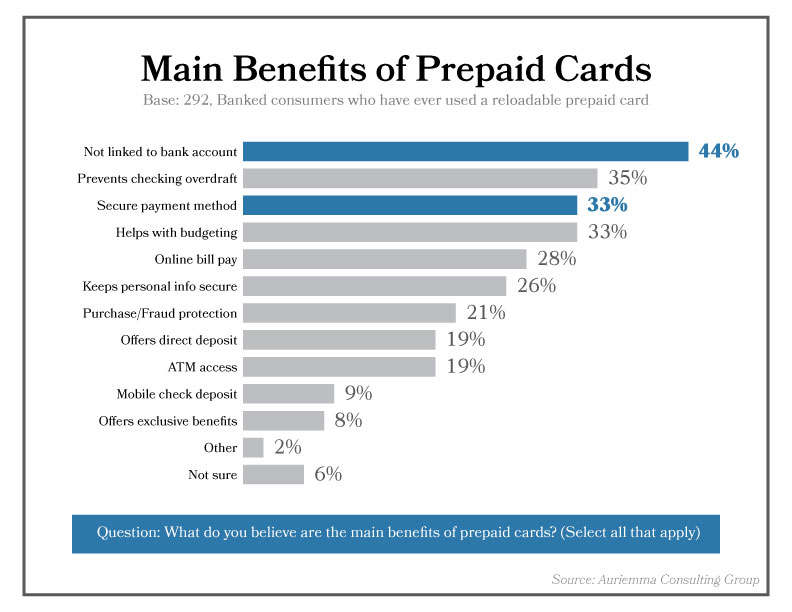Three Under-Tapped Markets and Use Cases for Prepaid Cards
 By Jaclyn Holmes, Auriemma Consulting Group
By Jaclyn Holmes, Auriemma Consulting Group
In some circles, it’s considered gospel that most reloadable prepaid card users fall into the unbanked category. But there are numerous under-tapped use cases and demographic profiles among banked consumers that could help prepaid issuers increase loads, usage and ongoing engagement, as we found in a recent consumer study conducted by Auriemma Consulting Group (ACG) in partnership with the Network Branded Prepaid Card Association (NBPCA).
The study, which collects attitudinal data from 800 banked consumers, reveals several opportunities for product enhancements and positioning based on how banked prepaid card users thought about and utilized the product. Millennials, for example, increasingly are eschewing traditional plastic (credit and debit) for alternatives they consider to be more secure and budget-friendly.
This millennial population, and other desirable demographic groups (such as users in the sizable 35 to 44 age range), are turning to alternatives, such as reloadable prepaid cards in response. Recognizing the security prepaid cards can provide, users turn to prepaid not only for online purchases, but also for their day-to-day spend, as a tool to budget or categorize their spending, and as a means to save for upcoming purchases.
 However, overall marketing visibility with these desirable groups is relatively low, with 65 percent of banked non-prepaid cardholders not seeing a need to use prepaid and 17 percent not knowing the use cases for the product. Here are three key ways to reverse that course.
However, overall marketing visibility with these desirable groups is relatively low, with 65 percent of banked non-prepaid cardholders not seeing a need to use prepaid and 17 percent not knowing the use cases for the product. Here are three key ways to reverse that course.
1. Highlight Security
At a time when headlines are populated with data leaks and various fraudster scams, security for funds is paramount to consumers. Reloadable prepaid cards are a particularly attractive payment alternative for consumers for whom security is top of mind. Despite having bank accounts, those who have used reloadable prepaid cards believe that the most beneficial aspects of the product are that they don’t link to their checking accounts (44 percent) and offer a secure payment method (33 percent). In fact, most consumers believe prepaid cards are more secure than credit (59 percent), debit (60 percent), and store cards (58 percent). And unlike cash, prepaid cards bring these security benefits to the digital shopping experience.
2. Integrate Prepaid Offerings within P2P and Mobile Wallets
Those who use prepaid are more likely to use P2P payments (47 percent) than those who primarily use debit cards (29 percent), according to the study. And 23 percent of P2P users have linked a prepaid card to at least one P2P platform (most notably Snapcash, People Pay, Zelle and Popmoney). Tapping into P2P users’ affinity for prepaid could create increased engagement with prepaid cards.
The commonalities between these user groups make a compelling case. Most current P2P payment users and prepaid cardholders are male (57 percent and 53 percent, respectively), college-educated (62 percent and 53 percent), parents of minors (56 percent and 50 percent), and report a household income of more than $50,000 (67 percent vs. 55 percent). The similarities in demographics point to the significant overlap for both audiences.
Users of both prepaid cards and P2P payments are more than just demographically similar. When looking at the perceived benefits of both payment methods, users of each report comparable advantages, namely security, budgeting and convenience. What’s more, the most frequently used card overall is typically the same card used in a mobile wallet, according to ACG’s Mobile Pay Tracker research. This points to a big top-of-wallet opportunity for prepaid issuers that market their integration with P2P and mobile wallets.
3. Focus on High-End Consumers
Those with a household income of $50,000 and up are more likely to reload their cards weekly (28 percent vs. 15 percent with less than $50,000) and typically reload a much higher amount ($585 vs. $142, implying a full or partial paycheck load). These prepaid users exhibit other attractive characteristics, including a higher likelihood to give prepaid cards as gifts (26 percent vs. 16 percent), to leave money for kids or babysitters (14 percent vs. 4 percent) and say they’re very satisfied with the fee structure (31 percent vs. 19 percent).
There are opportunities to attract more high-income users by increasing rewards associated with prepaid programs, such as discounts or access to events. Higher-end prepaid users are nearly three times as likely as their lower-income counterparts to cite exclusive benefits as a main benefit of the product.
While prepaid cards continue to be important to the unbanked, the results from this study show that banked consumers are also finding new and inventive ways to incorporate the product into their everyday spending behavior and represent a key opportunity for prepaid issuers.
Jaclyn Holmes is director of the payments insights practice at Auriemma Consulting Group. She directs ACG’s four syndicated consumer research publications (US Cardbeat, UK Cardbeat, The Payments Report, Mobile Pay Tracker), and is responsible for designing and analyzing research on consumer payment, borrowing and investing behaviors, and use of mobile payments, alternative payment providers and individual card products. She can be reached at [email protected].
In Viewpoints, payments technology professionals share their perspectives on the industry. Paybefore presents many points of view to offer readers new insights and information. The opinions expressed in Viewpoints are not necessarily those of Paybefore.











































